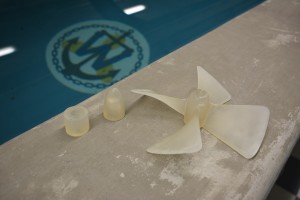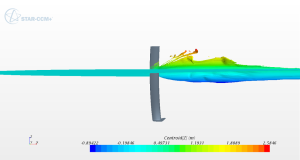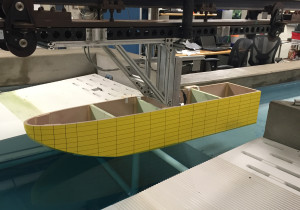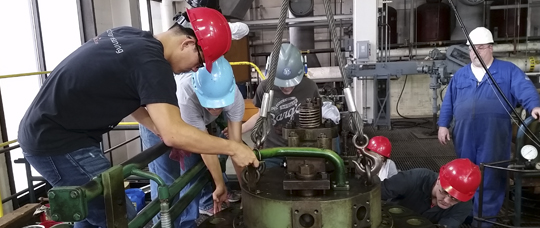(photo: The Class of 2016 working on a diesel engine during a class trip to Kings Point, NY)
Parametric Optimization of a Kiteboarding Hydrofoil Using CFD
Zachary Backas
The goal of this thesis is to improve the performance of a kiteboarding hydrofoil, or kitefoil, by building a parametric model based on the initial geometry and optimizing it using computational fluid dynamics (CFD). This thesis will outline a procedure for conducting optimization of parametric models in CFD. Using base geometry donated by the kitefoil manufacturer Deltafoil, a parametric model will be developed in the optimization CAESES to be tested and improved using CFD. Ultimately, the final optimized geometry produced will be compared to the initial geometry in CFD to assess the effectiveness of the optimization procedure.
Propeller Analysis of the USS Monitor
Thomas Brackin, Jennifer Lorenc, & Ilya Mouravieff
 This thesis will perform an analysis of the propeller of the USS Monitor, one of the most significant ships in the history of naval warfare. The primary objective is to determine the operating characteristics of the Monitor propeller. A corrected model of the original propeller will be created and tested in the Robinson Model Basin, and a scale model of the vessel will be used to perform resistance testing and a wake survey. Finally, the data collected will be used to design a wake adapted modern propeller optimized for the Monitor’s operating conditions. After comparing test results from the two propellers, the improvements in manufacturing techniques and propeller design will be identified. Additionally, this study will support the interests of the SNAME Marine Forensics Committee.
This thesis will perform an analysis of the propeller of the USS Monitor, one of the most significant ships in the history of naval warfare. The primary objective is to determine the operating characteristics of the Monitor propeller. A corrected model of the original propeller will be created and tested in the Robinson Model Basin, and a scale model of the vessel will be used to perform resistance testing and a wake survey. Finally, the data collected will be used to design a wake adapted modern propeller optimized for the Monitor’s operating conditions. After comparing test results from the two propellers, the improvements in manufacturing techniques and propeller design will be identified. Additionally, this study will support the interests of the SNAME Marine Forensics Committee.
An Investigation of the Value of Fluid Structure Interaction Analysis in Relation to the Design of Sailing Hydrofoils
Casey Brown & Cody Stansky
 This thesis will determine the value of analyzing fluid structure interactions, FSI, in relation to the design of high-performance sailing hydrofoils. This is being done by evaluating a carbon fiber, CV-style sailing hydrofoil, similar to those used in the most recent America’s Cup. The FSI analysis will be completed using StarCCM+ for CFD and Nastran in Solidworks for FEA, and integrating them using file-based coupling. The results from the FSI study will be compared to a CFD analysis of the un-deformed foil to determine the value of the FSI study.
This thesis will determine the value of analyzing fluid structure interactions, FSI, in relation to the design of high-performance sailing hydrofoils. This is being done by evaluating a carbon fiber, CV-style sailing hydrofoil, similar to those used in the most recent America’s Cup. The FSI analysis will be completed using StarCCM+ for CFD and Nastran in Solidworks for FEA, and integrating them using file-based coupling. The results from the FSI study will be compared to a CFD analysis of the un-deformed foil to determine the value of the FSI study.
The Economic Impact of the Mediterranean Refugee Crisis on the Shipping Industry
Glenn Burnett
This thesis investigates the financial costs that shipping companies incur when interacting with migrant vessels in the Mediterranean. The goal is to find an alternative that could save the shipping industry money while protecting commercial ships from dangers involved in direct interaction with migrant vessels.
Developing a Design Guide for Shipboard Deck Heating through Thermodynamic Analysis
Kathryn Chaffee
This thesis is an examination of deck heating systems on-board small ships operating in Arctic regions, specifically Arctic tugboats. The underlying objective is to develop the foundation for a basic design guide relating to these systems. In accomplishing this goal, the project will address a particular lack of publically available design knowledge. Moreover, it will provide information on a system likely to be in demand given the growth of maritime Arctic activities. The project will consist of extensive background research and a number of finite element heat transfer analyses conducted using Femap/Nastran. Basic models will be validated via manual computation.
A Modern Analysis of Historical Herreshoff Torpedo Boats
Kelly O’Brien
Nathanael Herreshoff was one of the most revolutionary designers in the history of naval architecture. In all of his years of successful design, however, he used model testing only for his torpedo boat designs. Rather than use traditional tank testing, Herreshoff developed his own method of comparative testing that could be done off the bow of his steam yacht. Through the generosity of his grandson, Halsey Herreshoff, this thesis will use two of “Captain Nat’s” original models, as well as his original test results. This thesis will test both Nathanael Herreshoff’s Standard Model and the test model used as the basis for the USN Torpedo boats Porter and Dupont, according to modern methods. These tests will evaluate the accuracy of Herreshoff’s testing methods and establish a data series for future comparison against Nathanael Herreshoff’s standard model.
An Economic Analysis of Unmanned Surface Vessels Operating in Offshore Markets
Dylan Froriep & Michael Walker
This thesis analyzes the economic feasibility of using unmanned surface vessels (USV) in several applications in the offshore industry. The different operations of USVs analyzed are oceanographic surveys, AUV tender operations, oil boom handling operations, and collaborative autonomy systems. This thesis also analyzes the applications of bolt-on autonomous systems for existing vessels to determine the economic competitiveness of repurposing existing vessels. The goal of this thesis is to identify the markets in which USVs are commercially competitive.
Vessel Seakeeping: Effect of Different Convex Buttock Curvatures at the Bow
Kurt Gavel
 The objective of this thesis is to determine the effects, with regard to vessel motions, of different bow shapes for planing hull forms. The study will focus on the convex radii of buttock curvature towards the bow. The accuracy of the VsSea 5-3b program written by Dr. William S. Vorus will also be verified by a comparison to model testing in the Robinson Model Basin at Webb Institute and Davidson Laboratory at Stevens Institute. Two hull forms based on a modified version of models used by Samuel Leshnover in 1953, both with a constant dead rise of 20 degrees from stem-to-stern, will be tested.
The objective of this thesis is to determine the effects, with regard to vessel motions, of different bow shapes for planing hull forms. The study will focus on the convex radii of buttock curvature towards the bow. The accuracy of the VsSea 5-3b program written by Dr. William S. Vorus will also be verified by a comparison to model testing in the Robinson Model Basin at Webb Institute and Davidson Laboratory at Stevens Institute. Two hull forms based on a modified version of models used by Samuel Leshnover in 1953, both with a constant dead rise of 20 degrees from stem-to-stern, will be tested.
The Effect of Dual-Fuel Methanol-Diesel Systems on Emissions and Engine Performance
Oleg Golubev
This thesis will test the effects of diesel-methanol, and if time allows, diesel-ethanol fuel emulsification on diesel engine emissions and performance. The goal is to find the optimal ratio of methanol/ethanol and diesel to lower emissions while minimizing adverse effects on fuel economy. For this purpose a fuel delivery system will be designed, assembled, and tested (off engine). Each fuel ratio will be tested through a matrix of operating conditions, where the optimal ratio will be found through a graphical and numerical analysis.
Concept Design of an Artificial Floating Island in the Caribbean Sea
Elijah Kim
Artificial floating islands have many different uses, ranging from offshore oil platforms to leisure. This thesis will explore the concept design of an artificial floating island in the Caribbean Sea that will serve as a private vacation home for a single family and its guests (maximum of up to ten people). The goal is to create a design that is both functional and aesthetically pleasing. Minimal vibrations, maximum stability, and safety are key factors in the design. Cost will be considered but will not have a major influence on the overall product since the target customers are not limited economically.
An Economic Analysis of Compliance with the Hong Kong Convention
Erin Hub
This thesis analyzes the new environmental policy surrounding the shipbreaking industry and then performs an economic analysis to see how these proposed changes will fit financially into the current shipbreaking market. This thesis will also analyze how these policies are changing the industry, and in turn, how incidents in the industry are influencing the policy that is being created and determining how these new policies will be enforced and how effective the enforcement will be.
An Investigation of Supercritical Carbon Dioxide as a Waste Heat Recovery Fluid
Brian Mills & Dylan Przelomski
In marine propulsion engines, a significant portion of energy is vented out the stack as heated exhaust gas. Many systems are being implemented to recover some of this energy, increasing the efficiency of the prime mover and saving fuel. Some waste heat recovery systems generate steam, augmenting an auxiliary boiler. More modern systems are focused on generating electricity, reducing the load on the ship’s service generators. A new waste heat recovery system utilizes supercritical carbon dioxide as a working fluid to generate electricity. The objective of this thesis was to evaluate supercritical carbon dioxide as a working fluid in waste heat recovery systems.
U.S. River Cruise Ship Design
Lauren West
This thesis will develop a business model and preliminary design for a Jones Act and USCG-compliant Mississippi River cruise ship. The business model will focus on an economic analysis and financial plan to demonstrate the competitiveness of the vessel design. The preliminary design will include a general arrangement drawing, a lines plan, a weights and centers report, powering estimate, and stability analysis. The objective of this thesis is to produce a competitive and attractive brand for the underserved U.S. river cruise market.
Development of a Mooring Analysis Program for Floating Wind Turbine Platforms
Andrew Ko
The objective of this thesis is to create a program that determines the maximum mooring tension of a semi-submersible FWTP.

